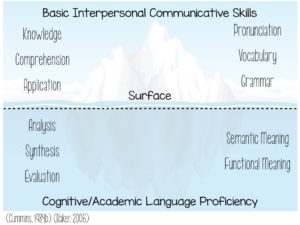I recently attended an insightful and interesting training session given by the funny and relatable Speech and Language Therapist and Bilingual expert, Sunita Shah. To sum up the training session...it blew my mind! I learned a ton of practical information and I know I'm not alone when I admit that I left the training session excited to have a wealth of new information while at the same time feeling a sense of dread that I am going to have to make quite a few adjustments to the way I assess and manage the bilingual children on my caseload! Below are five (of many many many!) facts that I learned from the training session.
1. I am a Bilingual!
One of the first things I learned in the training was that I am actually bilingual. In my head, a bilingual person has always been someone who can speak fluently in two languages. I come from a Gujarati background and can understand Gujarati really well however when it comes to speaking it...let's just say it's a great way to give my family members a good laugh . However, various definitions of bilingualism state that if you have any degree of proficiency in another language, you are considered bilingual.
So there you have it! My name is Trisha and I am a Bilingual! Woop woop!
2. Children will learn conversational language much sooner than they will learn academic language
The iceberg model shown above shows two very different sets of language skills.
Basic Interpersonal Communicative Skills involves the context embedded everyday language that occurs between conversational partners. Children will use these language skills in meaningful social situations such as the playground, the lunch room, while playing sports, or talking on the telephone. These skills are typically acquired within two years of learning the language.
Cognitive/Academic Language Proficiency refers to the context-reduced language of academic learning, including listening, speaking, reading and writing about subject area content. This is the language that is essential for student to have in order to succeed in school. It takes five to seven years for children to develop these language skills.
This information really opened up my eyes! While children may develop a conversational English that is adequate for everyday communication, they will still struggle in areas such as reading, writing, science, and other subject areas where there is little context to support the language being heard or read. As an SLP it is so important to take this knowledge into consideration when assessing these children!
3. Never ever use standardised scores with children who are bilingual
One of the big take home messages from the training course was that using standardised scores from standardised tests with children who are bilingual is a big BIG no NO!
Why? Well, because standardised tests have been standardised again a monolingual population of children. We all know this and have even been warned to take this into consideration when writing our reports and making decisions based off of the standardised scores that we get from our assessments. But for the first time, I truly understand why:
- Norms have been developed using monolingual English speakers
- We do not always know the developmental states of a child's home langauge
- The child may not be familiar with the testing situation
- You may not be testing the same thing if you translate an assessment
- There may be differences in culture
- The child may know the word in their home language but not the other
- The child may not have been exposed to the testing vocabulary
- The child may not understand the instruction
4. Assessment of Bilinguals does not have to be stressful
So if you can't use standardised scores with bilingual children, what do we do?
It was stressed throughout the training and really proven through the various case studies that we completed, that getting a complete case history of a child is so important when making clinical decisions. Knowing about additional languages, how long they have been learning these languages and whether the child is displaying difficulties with language at home are going to be really important when making clinical decisions.
Gain information about all languages by involving an interpreter to help you assess the home language. Whenever possible, use a non-biased interpreter over a family member of the child.
Use dynamic assessment to find out about the child's current level of functioning while also learning about the best way to facilitate further learning.
5. The language system of a bilingual progresses in a predictable manner
Another valuable piece of the puzzle that is bilingualism, was the fact that the language system of a bilingual child will progress through three predictable stages.
Stage 1: The child has one system composed of words from both languages.
Stage 2 (aka Interference): The child has separated vocabulary into two separate systems (one for each language) but is still using the sentence structure of the dominant language. At this stage, you may observe a child say something like 'He book not reading' which is not the correct word order in English but is the correct word order in their home language.
Stage 3: The child now has two separate language systems for vocabulary and for sentence structure.
When we are assessing children at school we often see children using incorrect sentence structure and it's really important to check whether this is interference (a typical stage of development) or part of a larger language disorder.
Stay tuned for Talking Tip Tuesday tomorrow!
I hope that the above information might inspire other SLPs/SLTs to look into best practices for working with the bilingual children on their caseload! Stay tuned for my Talking Tip Tuesday where I will be continuing on the Bilingual train of thought and sharing THE most important thing that Sunita stressed throughout the training session.



